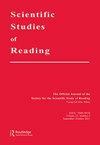Simple View of Reading Across the Transition from Kindergarten to Grade 1 in a Transparent Orthography
IF 2.4
2区 教育学
Q1 EDUCATION & EDUCATIONAL RESEARCH
引用次数: 0
Abstract
Purpose This longitudinal study investigated the simple view of reading (SVR) model and its cognitive basis in a transparent orthography of the Lithuanian across the transition from kindergarten to Grade 1.Method The language and early literacy skills of 229 children (Mage = 6.79, SD = .47) were tested at the end of kindergarten (vocabulary, letter knowledge, phonological awareness, and RAN); listening comprehension and word reading fluency were tested at the start of Grade 1; and reading comprehension was measured at the end of Grade 1.Results Together with parental education, word reading fluency and listening comprehension predicted reading comprehension (R2 = 43.2%). The second model, which also included language and early literacy skills, showed that vocabulary and phonological awareness indirectly predicted reading comprehension via listening comprehension, while phonological awareness, letter knowledge, and rapid automatized naming (RAN) indirectly predicted reading comprehension via word reading fluency (R2 = 43.6%). However, after allowing the direct paths from language and early literacy skills in kindergarten to reading comprehension, listening comprehension and word reading fluency were no longer significant predictors of reading comprehension, whereas vocabulary and letter knowledge were (R2 = 58.9%).Conclusion The results provided support for the SVR model in transparent Lithuanian orthography in that linguistic and decoding components are important for early reading comprehension. However, the results also suggested that, in the Lithuanian context, kindergarten vocabulary and letter knowledge are stronger measures in predicting reading comprehension than listening comprehension and word reading fluency in Grade 1.《透明正字法》中幼儿园到一年级过渡阅读的简单视角
目的本研究旨在探讨简单阅读观(SVR)模型及其在立陶宛幼稚园至一年级学生透明正字法学习中的认知基础。方法对229名幼儿(Mage = 6.79, SD = 0.47)在幼儿园结束时进行语言和早期读写能力测试(词汇、字母知识、语音意识和RAN);一年级开始进行听力理解和单词阅读流畅性测试;阅读理解在一年级结束时进行测试。结果单词阅读流畅性和听力理解与父母教育相关(R2 = 43.2%)。第二个模型(也包括语言和早期读写能力)显示,词汇和语音意识通过听力理解间接预测阅读理解,而语音意识、字母知识和快速自动命名(RAN)通过单词阅读流利性间接预测阅读理解(R2 = 43.6%)。然而,在允许从幼儿园的语言和早期读写技能到阅读理解的直接路径后,听力理解和单词阅读流畅性不再是阅读理解的显著预测因子,而词汇和字母知识则是(R2 = 58.9%)。结论支持透明立陶宛语正字法的SVR模型,语言和解码成分对早期阅读理解具有重要意义。然而,结果也表明,在立陶宛语境下,幼儿园词汇和字母知识比听力理解和单词阅读流利度更能预测一年级学生的阅读理解。
本文章由计算机程序翻译,如有差异,请以英文原文为准。
求助全文
约1分钟内获得全文
求助全文
来源期刊

Scientific Studies of Reading
Multiple-
CiteScore
7.20
自引率
2.70%
发文量
26
期刊介绍:
This journal publishes original empirical investigations dealing with all aspects of reading and its related areas, and, occasionally, scholarly reviews of the literature, papers focused on theory development, and discussions of social policy issues. Papers range from very basic studies to those whose main thrust is toward educational practice. The journal also includes work on "all aspects of reading and its related areas," a phrase that is sufficiently general to encompass issues related to word recognition, comprehension, writing, intervention, and assessment involving very young children and/or adults.
 求助内容:
求助内容: 应助结果提醒方式:
应助结果提醒方式:


